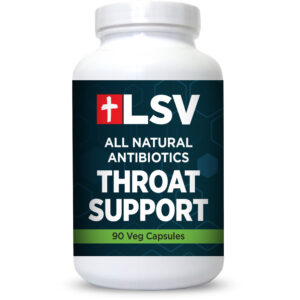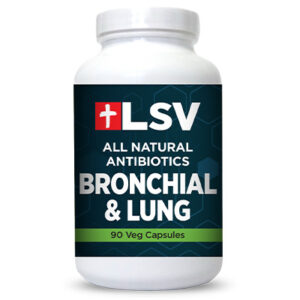Our Company
LSV
SINCE 1992
Founded in 1992, in Winter Park, Florida – LSV Vitamins has been the leader in All Natural Antibiotic supplement sales for over 30 years in the United States.

Garlic: A Natural Antibiotic Weapon?
Garlic, a pungent member of the Allium family, isn’t just a flavorful addition to your cooking. Throughout history and across cultures, it’s been used as a natural remedy for various ailments. Modern science is now catching up with tradition, revealing garlic’s potential as an antibiotic powerhouse.
The Science Behind the Spice
Garlic’s secret weapon lies in a compound called allicin. When you crush or chop a garlic clove, allicin is produced. This sulfur-containing compound is what gives garlic its characteristic odor and is also responsible for its antimicrobial properties.
Studies have shown that allicin can combat a wide range of bacteria, including both gram-positive and gram-negative types. It can even target antibiotic-resistant strains, offering a glimmer of hope in the fight against superbugs.
Garlic’s benefits extend beyond just killing bacteria. It can also disrupt the formation of biofilms, the sticky films bacteria produce to shield themselves from antibiotics and the immune system.
Not a Replacement, But a Potential Ally
It’s important to remember that garlic is not a magic bullet. While research is promising, more studies are needed to determine the effectiveness of garlic for treating specific infections in humans. Garlic should never be used as a substitute for prescribed antibiotics.
However, garlic’s potential as a complementary therapy is exciting. It could potentially boost the effectiveness of traditional antibiotics or help prevent infections in the first place.
How to Reap the Rewards
While there’s no magic dosage for garlic’s antibiotic effects, incorporating it into your diet regularly is a good place to start. Fresh garlic cloves seem to have the highest allicin content, although aged garlic extract and garlic powder may also be beneficial.
Study: Antibacterial Properties of Organosulfur Compounds of Garlic (Allium sativum) [PUBMED garlic antibacterial properties ON National Institutes of Health (.gov ncbi.nlm.nih.gov]) This study explores the various organosulfur compounds in garlic and their antibacterial effects, including allicin.
Study: Antibacterial activity of garlic extract on cariogenic bacteria: An in vitro study [PUBMED garlic antibacterial cariogenic bacteria ON National Institutes of Health (.gov ncbi.nlm.nih.gov]) This study investigates the effectiveness of garlic juice compared to a chlorhexidine mouthwash against cariogenic bacteria, showing promise for oral health.
Study: Antimicrobial properties of hydrophobic compounds in garlic: Allicin, vinyldithiin, ajoene and diallyl polysulfides (Review) Spandidos Publications: [antimicrobial properties of hydrophobic compounds in garlic allicin vinyldithiin ajoene and diallyl polysulfides review ON Spandidos Publications spandidos-publications.com] This review dives into the different hydrophobic compounds in garlic and their antimicrobial properties, highlighting the challenges of allicin reaching its target sites within the body.
These studies provide a good starting point for exploring the research on garlic’s antibiotic properties. Remember, these are just a few examples, and many more studies are ongoing in this field.
The Final Word
Garlic may not be a cure-all, but its potential antibiotic properties are a fascinating area of research. Including garlic in your diet, alongside a healthy lifestyle, could offer an extra layer of defense against bacterial foes. Remember, it’s always best to consult with a healthcare professional before using garlic for medicinal purposes.
By no means are we at LSV Vitamins saying do not take what your doctor prescribes, we are just saying that we have an alternative for those who cannot take Antibiotics, afraid of one of the many side effects, or simply want to try an all-natural alternative. We have a large number of people (over 100,000) who take and have taken this at the first sign of a problem, and it works well. As always, consult your doctor.
LS Vitamins – Since 1992
See All of our effective All Natural Products Here
All Natural Antibiotics Cold & Flu
All Natural Antibiotics Sinus Support
All Natural Antibiotics Teen Support
All Natural Antibiotics Tooth & Gum
All Natural Antibiotics Bronchial & Lung Support
All Natural Antibiotics Throat Support
Below are a number of statistics that help describe how antibiotics are currently being prescribed in outpatient settings in the United States and how these practices are contributing to the larger issue of antimicrobial resistance.
The possibility of antibiotic side effects can be frightening, but it is important to remember that their proper use has saved countless lives. Those using antibiotics should report any possible negative reactions to their doctor immediately. In some cases, doctors will have their patients continue using a specific antibiotic if the side effects are mild; in others, the doctor will switch the patient to another drug.
For Over 30 Years, we have 3rd Party Tested each and every nutrient that go into all of our products: Purity & Effectiveness is how are product continually works for Tens of Thousands of our Customers.
*Disclaimer: None of the above statements have been evaluated by the FDA. These products are not intended to diagnose, treat, cure or prevent any disease. As always, consult your physician before taking any supplements. LSV. Individual results may vary.
 Throat Support - Natures Antibiotics
Throat Support - Natures Antibiotics
 Bronchial & Lung Support - Natures Antibiotics
Bronchial & Lung Support - Natures Antibiotics
LSV
SINCE 1992
Founded in 1992, in Winter Park, Florida – LSV Vitamins has been the leader in All Natural Antibiotic supplement sales for over 30 years in the United States.